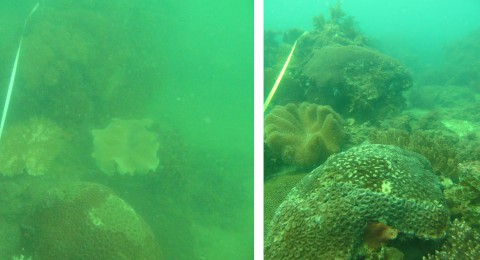Wet versus wetter on the Great Barrier Reef; River runoff, water clarity and reef communities
The last decade in north Queensland has seen a striking contrast of summers of below median rainfall (2002-2006) and ‘big wets’ (2007-2012). The run of relatively dry summers, followed by the years of high summer rainfall created perfect conditions for researchers to study the effects of river runoff on water clarity in the Great Barrier Reef (GBR) lagoon.
Water clarity or photic depth is the extent that light can penetrate through the water. On coral reefs, water clarity is influenced by two main factors; the type and amount of sediments in the water, and the type and amount of plankton. On reefs exposed to runoff from the land water, clarity is lower throughout the year. Sediments that have settled on the seafloor get resuspended by wind and tidal currents, and this has made it hard to measure, the area, the timeframe and the magnitude of the effect of river runoff on reefs of the GBR.
An recent analysis of coastal water clarity through time in the region around the Burdekin River, found that once the influence of wind and tide re-suspension are removed, it can be seen that river runoff affects water clarity up to 80 km from the coast. During the six wet years mean photic depth was 20% lower compared to the four dry years (Figure 1). In wet years, water clarity was below water quality guidelines for the GBR for 156 days, compared to 9 days in the drier years.1
Prolonged periods of low light causes stress to marine organisms that obtain energy from photosynthesis such as seagrass, algae and corals. Research from reefs in the Whitsunday Islands ( to the south of the Burdekin) showed that while most types of adult corals were resistant to the adverse conditions during the wet years from 2007-2012, there was a reduction in the abundance and change in the species composition, of juvenile corals, suggesting that stressors during extreme years are shaping the communities for years to come2. The reduction of light with depth increases rapidly over a small depth range. During the wet years at two meters light levels were calculated as 74 % of surface irradiation, but at five meters, light levels dropped to 20 %, placing them slightly above the lower limit of light for reef development of 6-8%.3
The map shows a summary of 1. the RRMMP inshore water quality monitoring and coral reef monitoring 2.NRM regions flowing into the GBR and 3. NERP 4.1 sampling area. Click on the 4-arrow square to enter the mapping system for more information
Overall the results of these studies suggest that sediments flowing into the GBR lagoon during prolonged periods of wet are creating conditions that are stressful for marine organisms and in particular juvenile corals. Turbidity or low water clarity can also be a result of re-suspension of sediments in the coastal lagoon system by natural processes or from activities such as shipping or dredging. However the close relationship of river runoff with light and sediment levels suggests that continued reductions in river loads would measurably improve water clarity in the GBR lagoon, with significant ecosystem health benefits.
References
1. Fabricius KE, Logan M, Weeks S et al. The effects of river run-off on water clarity across the central Great Barrier Reef. Marine Pollution Bulletin 2014;84.
2. Thompson A, Schroeder T, Brando V et al. Coral community responses to declining water quality: Whitsunday Islands, Great Barrier Reef, Australia. Coral Reefs 2014; online early view, accessed 29/10/2014
3. Cooper TF, Uthicke S, Humphrey C et al. Gradients in water column nutrients, sediment parameters, irradiance and coral reef development in the Whitsunday Region, central Great Barrier Reef. Estuarine, Coastal and Shelf Science Elsevier, 2007;74:458–470. https://www.sciencedirect.com/science/article/pii/S0272771407001412.





